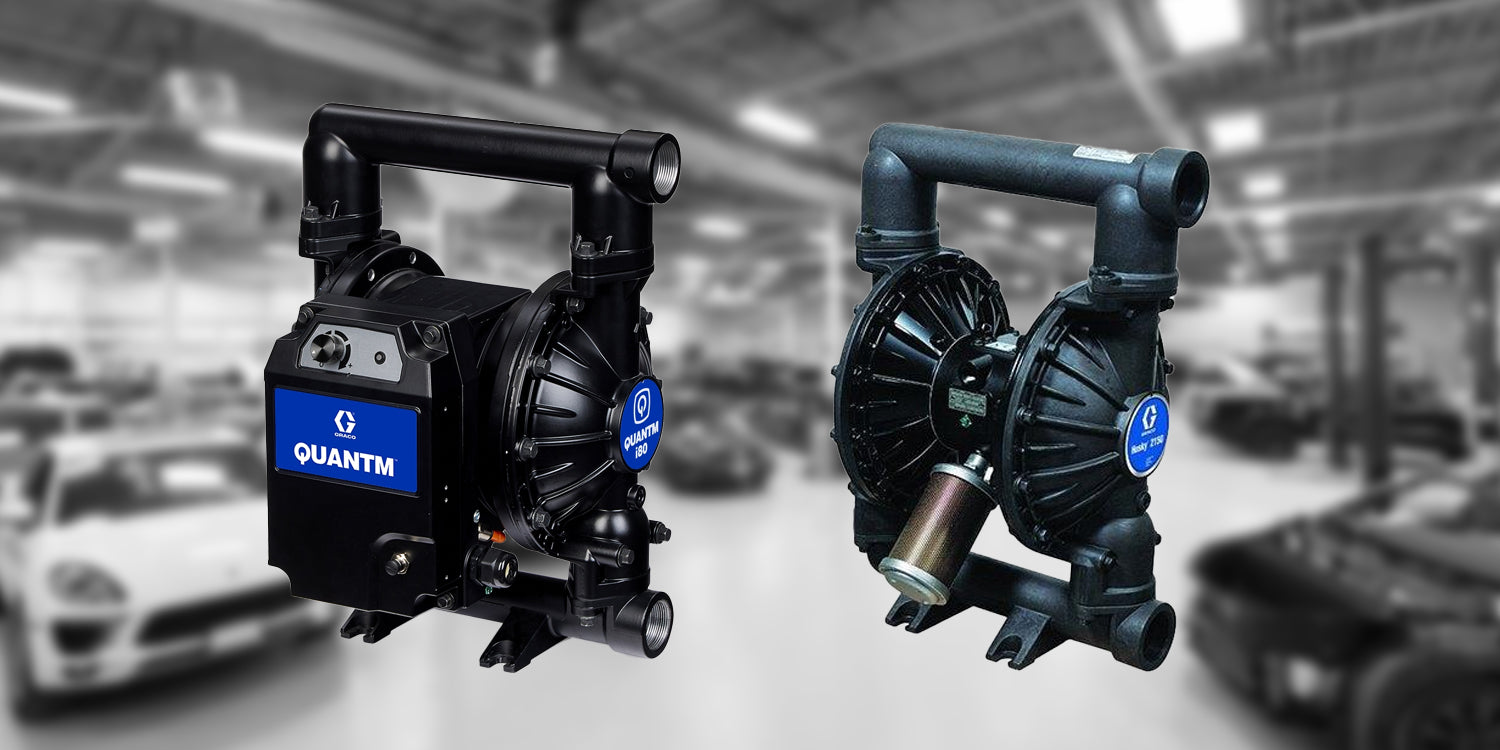When it comes to choosing the right pump for your auto body shop, the decision between electric and air-operated pumps can be daunting. Both Graco's Quantm EODD and Husky AODD pumps offer unique advantages, but which one is best suited for your needs? In this article, we will delve into the key differences between these two types of pumps, focusing on their power source and efficiency, maintenance and durability, flow control and priming, handling of fluids, cost considerations, safety in hazardous environments, and operational capabilities.
Power Source and Efficiency
Graco's Quantm EODD pumps are electrically operated, using FluxCore drives that reduce energy usage and costs by up to 80% compared to pneumatic pumps. This makes them a cost-effective option for auto body shops looking to minimize their operational expenses.
On the other hand, Husky AODD pumps are operated by compressed air, which is less energy-efficient due to the energy-intensive air compression process. While they may have a lower upfront cost, their operational costs can be higher due to the need for air compressors and frequent repairs.
Maintenance and Durability
Quantm EODD pumps have a longer lifespan with fewer moving parts, requiring low maintenance due to their simple design and fewer components. This means less downtime and more time spent on actual work in your auto body shop.
Husky AODD pumps, however, require more frequent maintenance for diaphragms and valves, experiencing more wear and tear. This can lead to increased maintenance costs and potentially more frequent repairs.
Flow Control and Priming
Quantm EODD pumps offer precise flow control and are self-priming with smooth flow, aided by smart control technology to prevent dry running cavitation. This ensures consistent performance and minimizes the risk of pump failure.
Husky AODD pumps have less precise flow control, dependent on air pressure, but are also self-priming. While they can handle various fluid types, their flow control might not be as consistent as that of the Quantm EODD.
Handling of Fluids
Both types of pumps can handle a wide variety of fluids, including viscous, abrasive, and corrosive substances. However, Quantm EODD pumps are particularly adept at handling low viscosity fluids and can run dry indefinitely without damage. This makes them ideal for applications where fluid consistency is crucial.
Cost Considerations
Quantm EODD pumps have a higher upfront cost but lower operational costs due to energy savings. Over time, this can lead to significant cost savings for your auto body shop.
Husky AODD pumps have a lower initial cost but higher operational costs due to the need for air compressors and frequent repairs. While they might be more budget-friendly initially, their long-term costs can add up.
Safety and Hazardous Environments
Husky AODD pumps are safer in explosive atmospheres because they have no electrical components, making them ideal for such environments. This is particularly important for auto body shops that work with flammable materials.
Quantm EODD pumps are less suitable for explosive atmospheres due to their electrical components. However, they offer superior performance and efficiency in most other environments.
Operational Capabilities
Quantm EODD pumps can handle large bulk flow rates and have a wide operating range, accommodating a broad spectrum of fluids without compromising performance. They are versatile and can be easily integrated into various industrial processes.
Husky AODD pumps are valued for their versatility and ability to handle temporary or remote deployments due to their lightweight and portable design. They are excellent choices for applications where mobility is crucial.
Conclusion
Choosing between Graco's Quantm EODD and Husky AODD pumps for your auto body shop depends on several factors, including your specific operational needs, budget constraints, and safety considerations. While both pumps offer unique advantages, Quantm EODD pumps stand out for their energy efficiency, low maintenance requirements, precise flow control, and superior performance in most environments.
Elevate your industrial operations with HMFT's comprehensive solutions. Beyond offering top-tier industrial equipment, we deliver unparalleled maintenance and repair services through our elite team of factory-trained technicians. Experience seamless performance and maximize uptime with our expert support, ensuring your equipment operates at peak efficiency. Trust HMFT to be your all-in-one partner for industrial excellence, from cutting-edge equipment to precision maintenance.
FAQ
- Q: What are the primary differences between Graco's Quantm EODD and Husky AODD pumps?
- A: The primary differences lie in their power source and efficiency. Graco's Quantm EODD pumps are electrically operated and highly energy-efficient, while Husky AODD pumps are operated by compressed air and less efficient.
- Q: Which pump is more cost-effective in the long run?
- A: Graco's Quantm EODD pumps are more cost-effective in the long run due to their energy savings and lower operational costs.
- Q: How do the maintenance requirements differ between the two pumps?
- A: Quantm EODD pumps require less maintenance due to their simpler design and fewer moving parts, while Husky AODD pumps need more frequent maintenance for diaphragms and valves.
- Q: Which pump is safer in explosive atmospheres?
- A: Husky AODD pumps are safer in explosive atmospheres because they have no electrical components.
- Q: Can both pumps handle abrasive fluids?
- A: Yes, both pumps can handle abrasive fluids, but Quantm EODD pumps are particularly adept at handling low viscosity fluids and can run dry indefinitely without damage.
- Q: What is the initial investment for each type of pump?
- A: The initial investment for Graco's Quantm EODD pumps is higher, while Husky AODD pumps have a lower initial cost.
- Q: How do the operational costs compare between the two pumps?
- A: The operational costs for Husky AODD pumps are higher due to the need for air compressors and frequent repairs, while Graco's Quantm EODD pumps have lower operational costs due to energy savings.

